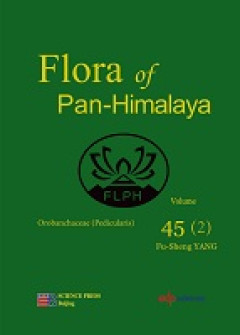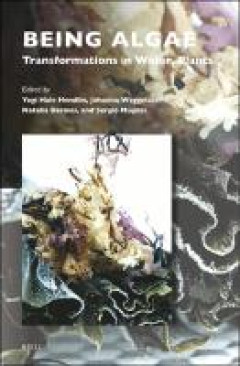Ditapis dengan
E-book Plants and vegetation of NW Ethiopia : A new look at Rodolfo E.G. Pic…
d more in the development of science, particularly in Ethiopia, because the Italian language in which they are published is not more widely read. These results should be more widely known, and the present authors hope that this publication will help to remedy that problem. We provide commented translations of the papers that present the field observations and we analyse the update…
- Edisi
- -
- ISBN/ISSN
- 9788855186346
- Deskripsi Fisik
- 360 hlm
- Judul Seri
- -
- No. Panggil
- 580 FRI p

E-book Flora of Pan-Himalaya: Orobanchaceae (Pedicularis)
Botany and plant sciences.
- Edisi
- -
- ISBN/ISSN
- 9782759830992
- Deskripsi Fisik
- 359 halaman, ilus.
- Judul Seri
- -
- No. Panggil
- 580 YAN f

E-book Being Algae: Transformations in Water, Plants
Water plants of all sizes, from the 60-meter long Pacific Ocean giant kelp (Macrocystis pyrifera) to the micro ur-plant blue-green algae, deserve attention from critical plant studies. This is the first book in environmental humanities to approach algae, swimming across the sciences, humanities, and arts, to embody the mixed nature and collaborative identity of algae. Ranging from Medieval Isla…
- Edisi
- -
- ISBN/ISSN
- 9789004683310
- Deskripsi Fisik
- 351 halaman, ilus.
- Judul Seri
- -
- No. Panggil
- 579.8 HEN b
E-book Plant (DK/Google E.guides)
Looks at core topics from many angles, using facts, 3-D models, data boxes, charts, and more, bringing together the best of the Web with DK's outstanding reference books. e.guides Plant has its own Web site, Create by DK and Google. When you look up a subject in the book, the article gives you key facts and displays a keyword that links you to extra information online.
- Edisi
- -
- ISBN/ISSN
- 9780756619541
- Deskripsi Fisik
- 100 halaman, ilus.
- Judul Seri
- -
- No. Panggil
- 580 BUR p
E-book The Encyclopedia of Essential Oils: The Complete Guide to the Use of A…
- Edisi
- -
- ISBN/ISSN
- 9780007145188
- Deskripsi Fisik
- 498 halaman, ilus.
- Judul Seri
- -
- No. Panggil
- 580.3 LAW t
- Edisi
- -
- ISBN/ISSN
- 9780007145188
- Deskripsi Fisik
- 498 halaman, ilus.
- Judul Seri
- -
- No. Panggil
- 580.3 LAW t
E-book Botany Illustrated : Introduction to Plants, Major Groups, Flowering P…
The major category is called a division and is equivalent to phylum in the animal kingdom. Division name endings indicate plants (-phyta) and fungi (-mycota). In the top illustration are some examples of Magnoliophyta, the flowering plant division. The endings of lesser categories indicate class (-opsida), subclass (-idea), order (-ales), and family (-aceae). Classification of one specific plan…
- Edisi
- -
- ISBN/ISSN
- 0387288759
- Deskripsi Fisik
- 291 hlm
- Judul Seri
- -
- No. Panggil
- 580 GLI b
E-book Introduction to Botany
Botany is the scientific study of plants and plant-like organisms. It helps us understand why plants are so vitally important to the world. Plants start the majority of food and energy chains, they provide us with oxygen, food and medicine. Plants can be divided into two groups: plants1 and plants2. Plants1 contain all photosynthetic organisms which use light, H2O, and CO2 to make organic compo…
- Edisi
- -
- ISBN/ISSN
- -
- Deskripsi Fisik
- 192 hlm
- Judul Seri
- -
- No. Panggil
- 580 SHI i

Fundamental of Botany
- Edisi
- -
- ISBN/ISSN
- 0-7069-0775-2
- Deskripsi Fisik
- 698 hlm.16x24 cm
- Judul Seri
- -
- No. Panggil
- 580 BIL f
- Edisi
- -
- ISBN/ISSN
- 0-7069-0775-2
- Deskripsi Fisik
- 698 hlm.16x24 cm
- Judul Seri
- -
- No. Panggil
- 580 BIL f
 Karya Umum
Karya Umum  Filsafat
Filsafat  Agama
Agama  Ilmu-ilmu Sosial
Ilmu-ilmu Sosial  Bahasa
Bahasa  Ilmu-ilmu Murni
Ilmu-ilmu Murni  Ilmu-ilmu Terapan
Ilmu-ilmu Terapan  Kesenian, Hiburan, dan Olahraga
Kesenian, Hiburan, dan Olahraga  Kesusastraan
Kesusastraan  Geografi dan Sejarah
Geografi dan Sejarah